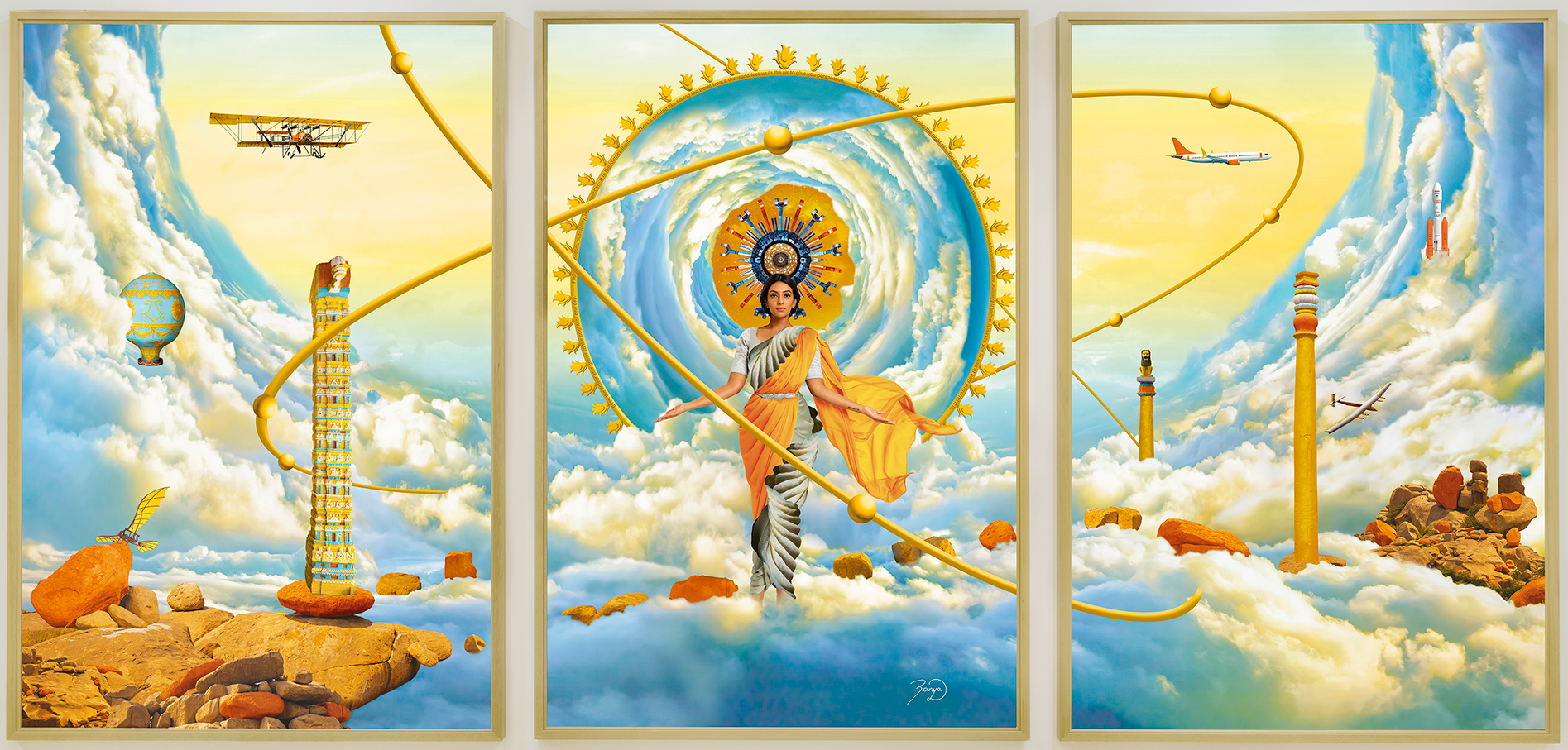At Bangalore International Airport HQ
Birthing the Cosmos
The surreal skyscape representing the past, present, and future, speaks of the birth of the cosmos and incorporates into it the story of flight. The central figure is Aditi, an often overlooked yet powerful female representation of Brahma (the creator). As the goddess of the sky, the past and future and the primordial goddess of infinity and fertility, she embodies the perfect symbolisation of this work. The mother to all Adityas,1 she is the cosmic creator and builds the surreal world we see. She acts as a ‘synthesis of all things’2 in this artwork, and opens up the ‘infinite, shoreless, expanse of possibility’.2
Parts of the Nataraja—the dance of creation—are used symbolically in this work. The circle symbolises the universe and the the changing forms of energy. The golden arch of flames (prabha mandala) represents the cosmic fire that, in Hindu cosmology, creates and consumes everything in a cyclical existence. It is the manifest universe and symbolises the circle of birth and rebirth. The creation and churning of this new world are seen through multiple perspectives—both the large and the small.
The central portal depicts the first moments of creation, and is orbited by eight spheres that symbolise multiple facets of our universe. On a micro scale, the eight spheres represent the smallest of particles—the atom, which is the building block of creation. If you imagine our goddess as the nucleus, then the atom represented here is that of oxygen (O2), the life force behind our existence and the most precious element of our atmosphere.
On a macro scale, the spheres and orbits depict our solar system and our eight planets at their moment of creation. The eight spheres also represent the eight Adityas (Aditi’s children), as directed in the Rigveda. These Aditya’s represent the essential elements and the building blocks of life on our world.
The ‘halo’ on the goddess’s head is actually the artist’s recreation of the core of the Large Hadron Collider—the only manmade construction that attempts to explore the beginnings of the cosmos and where we come from. Its launch united the world in a shared awe and understanding of our origins. The halo symbolises the oneness of humanity, and our shared source of creation.
The story of Flight
This artwork is broken up into three panels. The first panel handles flight at its beginning (the past) and the third panel delves into the possibilities of flight (the future). Aditi, as the goddess of the past and the future, sits in the central panel.
The elements of flight included are:
- • Leonardo Da Vinci’s prototype of the Ornithopter
- • The first hot-air balloon and man’s first flight
- • India’s first airplane flight, which is also the world’s first mail service flight
- • The commercial jet plane
- • A solar airplane and
- • A space rocket
The Pillars
The pillars are from different parts of the country and represent three of its religions:
- The Vijayanagar Pillar from Hampi (Hinduism),
- The Delhi Pillar at the Qutub Minar3 (Islam) and
- The Ashoka Pillar (Buddhism)
Their inclusion symbolises the unity and oneness of our people and points to the oneness of our origin. Moreover, etchings on the pillar in the left panel—taken from the ancient ruins of Hampi—tell the history and story of Karnataka’s civilisation.
Taking this concept further, this story does not have only one voice. Interviews of people from all ages, occupations, genders and vastly different walks of life in Bengaluru are incorporated into the golden arch to put forth a dream of the collective people.
- 1.The 8 Adityas are: Varuna, Mitra, Aryaman, Daksha, Bhaga, Amsha, Surya and Martanda.
- 2.Upanishads, translated by Arun Kumar (Sanskrit and Vedic Academy).
- 3. While the pillar was certainly used as a trophy in building the Quwwat-ul-Islam mosque and the Qutub complex, its original location, whether on the site itself or from elsewhere, is debated. Although it has been thought to have been erected elsewhere and constructed by Chandragupta II, it has stood in the Qutub complex since 1109.


